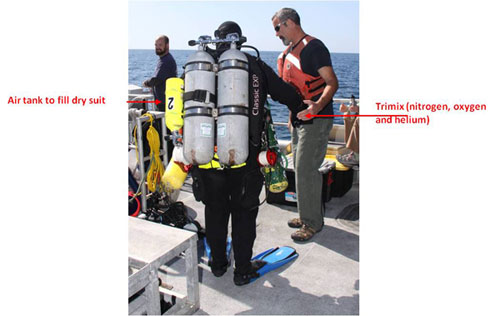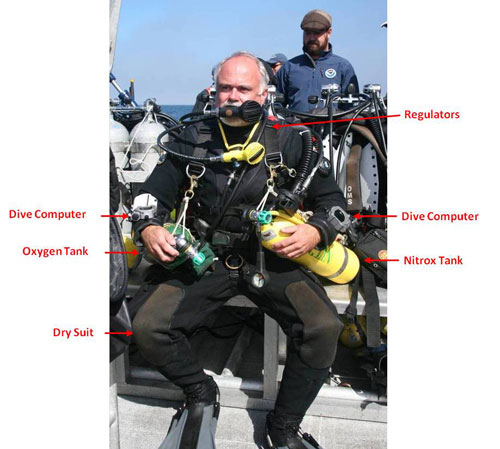Error processing SSI file
|
What is Technical Diving?
By Greg McFall,
Deputy Superintendent/Research Coordinator
Gray's Reef National Marine Sanctuary
Technical diving is simply the use of advanced (technical) techniques to allow divers to use open-circuit scuba equipment and mixed gas to a depth of 300 feet. Let's start with the "gas" that we're breathing; the air that we breathe at sea level is comprised of 79% nitrogen (and other trace gases) and 21% oxygen. Both of these gases are safe to breathe at the surface but both of them can become dangerous for different reasons when breathed under pressure.
Nitrogen is the gas that is associated with decompression related illnesses commonly known as the "bends." Nitrogen is an inert gas which is not used in any of the body's pulmonary or circulatory functions but is readily absorbed into both the blood and tissues. As we dive deeper and the water exerts increased pressure on our bodies, the nitrogen bubbles are compressed and easily enter the bloodstream from the lungs and are transported throughout the body's tissues.
Once we begin to ascend (go up) and the water pressure decreases, these nitrogen bubbles begin to come out of solution in the tissues and re-enter the bloodstream. If these bubbles are not allowed enough time to exit the body through the lungs, they can expand to the point that they do not travel well in the bloodstream and become lodged in blood vessels, the lung's tissues, the heart or in the brain and can cause serious complications. Another effect of nitrogen is one which makes the diver feel light headed and is referred to as narcosis; this effect increases with depth and can severely interfere with a diver's good judgment. One can quickly see that decreasing the amount of nitrogen that a diver breathes would be a good idea ... now for a look at oxygen.
Oxygen is a necessary component of the air that we breathe and without it we would perish. Like the saying goes though, "too much of a good thing can be a bad thing" and such is the case with oxygen. As a diver goes deeper into the ocean, the pressure of the oxygen component of the breathing mixture increases correspondingly to the point that it can actually become toxic to the body. This toxicity can result in a variety of symptoms including convulsions, blurred vision, ringing in the ears, nausea, a tingling sensation in the fingers or toes, a ringing noise in the ears and dizziness. So how does a deep diver deal with all these problems? The answer can be found at a birthday party...

Helium is a gas that we become very familiar with at an early age because of the gas- filled balloons that defy gravity and due to the fact that it makes us sound like Mickey Mouse if we inhale some of it and then try to talk.
Helium in a diver's gas mixture helps to displace the toxic effects of oxygen and the narcotic (and physiological) effects of nitrogen but is not used, retained or consumed by the human body. Using helium to displace the volume of nitrogen and oxygen in our breathing mixture is the key to diving deeper to explore our oceans natural beauty and bounty.
Technical Diving Equipment
Most scuba divers wear a wetsuit to keep them warm. They also wear fins to help them move underwater and a mask so they can see; this is pretty much where the similarities between regular scuba divers and technical divers end. Because technical (or tech) divers can go up to three times deeper than the traditional scuba diver, we need to take extra precautions to ensure that we're safe on the dive. Much like gasoline in a car where you need to have a larger gas tank for a longer trip (without stopping), tech divers need more breathing mixture in the tanks from which they breathe. Where a recreational diver can wear a single tank for a dive to 60 feet, we have to wear double tanks (which are also larger) so that we have enough breathing mixture to cover the time from leaving the surface to leaving the bottom of the ocean. These two tanks each have an independent regulator attached to them and a valve between the tanks can be closed in case one of the tanks begins to leak.


After we've left the bottom we begin to start breathing from the regulator on a decompression tank on our left side which is strapped to a harness we wear that holds the double tanks to our back. This gas mixture contains a higher percentage of oxygen but not so much that it becomes toxic. By increasing the percentage of oxygen as we ascend, we speed the removal of nitrogen from our bodies. Once we get to about 20 feet from the surface, we breathe 100% oxygen from a regulator attached to a tank on our right side.
Because we're diving at Cordell Bank and at depths of up to 200 feet, the water can be very cold which requires that we wear a dry suit. This special suit traps a layer of air between the diver's body and the suit which is kept warm by the heat of the diver's body. As we now know, as we descend, the water pressure increases and the air inside the dry suit is crushed; if this were not corrected, the suit would squeeze the diver's body and make it very uncomfortable to move. To counteract this pressure, the diver wears yet another (but small) tank which is connected to the suit and allows pressurized air to be added to the suit through a button that can be pushed by the diver.
Have you ever thought of taking your computer underwater? Well we have to have two of them! No, you can't connect to Facebook or Twitter but the computers we wear are crucial to our safety. They are small, wrist-mounted computers that keep track of our dive time, our depth and the gas mixture that we're breathing; from this information they can calculate how long it will take for the nitrogen to get out of our bodies (this is known as "decompression") and for us to safely return to the surface. For a twenty minute dive to 200 feet, we will have to spend up to an hour in decompression.
Now you might ask, "Who would want to do this and why is it important?" Many of the resources that we characterize, monitor and protect lie in waters deeper than can be reached by recreational-type diving.
It has been said that we know more about the surface of the moon than we do about the ocean's depths between 100 and 300 feet. Most of our National Marine Sanctuaries contain areas that lie within this depth range and which, until the last few years, have remained inaccessible to managers, scientists, educators and our outreach people who take the messages of the sanctuary's successes out to public. Remotely operated vehicles (underwater robots or ROVs) and manned submersibles can go to these depths but they are better suited for operations of a much deeper nature. Added to this is the fact that an ROV or submersible cannot do the same things underwater that a diver can do.
 Many people ask me, "Why did you decide to do this type of diving, isn't it dangerous?" Like many of the divers who choose this method of diving, I do it for the challenge and for the fact that you can see places and things that no one else has ever seen before. Keep in mind though, that you can't just go out and buy the equipment and start this type of diving; you have to go through very intensive training and conduct many training dives to be qualified and certified to conduct these types of dives. That being said, the pay-off in terms of the wonder of exploring new places and being able to bring that information back for others to experience is well worth the time, price and patience needed to conduct technical dives.
Many people ask me, "Why did you decide to do this type of diving, isn't it dangerous?" Like many of the divers who choose this method of diving, I do it for the challenge and for the fact that you can see places and things that no one else has ever seen before. Keep in mind though, that you can't just go out and buy the equipment and start this type of diving; you have to go through very intensive training and conduct many training dives to be qualified and certified to conduct these types of dives. That being said, the pay-off in terms of the wonder of exploring new places and being able to bring that information back for others to experience is well worth the time, price and patience needed to conduct technical dives.
|



